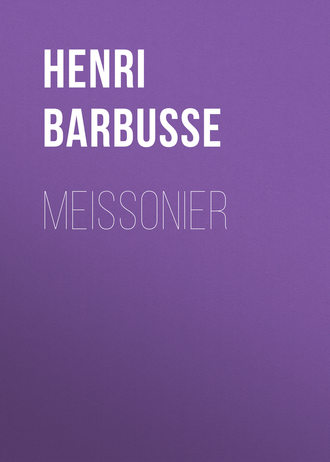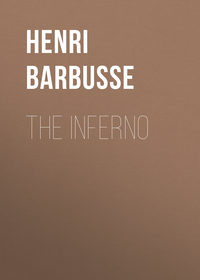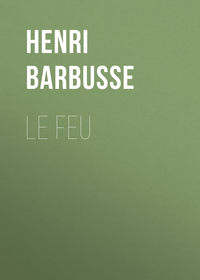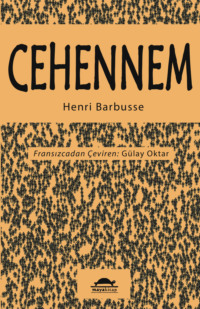 полная версия
полная версияMeissonier

Meissonier
INTRODUCTION
ONE day – it was neither in war time nor during manoeuvres – on a July morning, with the sun shining radiantly, a squadron of cuirassiers passed at full gallop across a magnificent field of ripening grain, in the neighbourhood of Poissy, although on every side there were wide reaches of fallow land and pasture.
When this hurricane of horses and men had, like a blazing meteor, devastated and laid low the splendid gold of the crops, two men remained behind, surveying the scene with visible satisfaction and undisguised interest.
One of the two was tall and the other short. The tall man was Colonel Dupressoir, who had directed the manoeuvre. The other, an elderly man, short of leg, and ruddy of complexion, with a long beard, white and silken, and a singularly expressive eye, was the painter, Meissonier. The latter had achieved his object. Thanks to long insistence and the payment of indemnities, he had brought about the passage of cavalry across that field, in order that he might make studies from nature, needed for a painting then in hand, 1807, of how standing grain looks after it has been crushed and trampled by the onrush of a charge.
The whole artist, whose work we are about to study side by side with his life, is summed up in this anecdote. It reveals one of the most typical sides of his temperament, and, consequently, of his talent: a constant and scrupulous endeavour, maintained even at the price of sacrifices that would seem excessive to the layman, to interpret nature precisely as she is. It was this noble ambition – and we shall find other examples of it in the course of an artistic career in which it was the dominant note – that made him say to his pupils, with a conviction that commanded respect: “If I should sketch a horse from memory I should feel that I had been guilty of an insult to nature!”
And it is because he conceived his ideal after this fashion that this unerring painter of so many military types and scenes never attempted to picture skirmishes or battles. It was not that he did not want to, or had not cherished the dream of doing so. But he had never seen a battle; and a battle is a thing that cannot be reconstructed, like a marching column or a detail of camp life. Accordingly he painted none, because he decided, with a certain loftiness, that he did not really know what a battle was!
Let us keep this attitude of mind before us, and even underscore it in our memory. For this alone, in a vague way, would suffice to characterize the artist with whom we are concerned; and his whole long, rich, and fruitful career may be summed up as a successful and varied application of one great principle: devout and inflexible respect for reality.
EARLY YEARS
When Jean-Louis-Ernest Meissonier was born at Lyons in 1815, under the fading light of an Imperial sunset, these were scarcely the ideas that predominated in the national school of French art. Pictorial art, to confine ourselves to that, had, both before and during the First Empire, achieved at most a lumbering and trammelled flight; and the influence of antiquity, so perceptible in the language as well as in the manners and fashions at the close of the Eighteenth Century, served only to confine the inspiration of artists more strictly within the bounds of classic tradition. Roman characters, Roman costumes, Roman virtues, – such was the ideal to which each debutant who did not revolt openly must make surrender! To be sure, the commanding figure of David gave a magnificent prestige to this rather cold and dishearteningly classic programme. But, like all great artists, David was exceptional; and he stands today as the only one who, in an epoch sadly poor in genius, produced a host of living masterpieces, to swell the lists of a school so artificial that it would now be forgotten, save as an echo of his name. It is true that, by way of ransom, he spent much time in painting vast canvases that today hold but a small place in his life work.
On the threshold of the Nineteenth Century, in 1799, Eugène Delacroix was born. It was he who brought a new spirit into French painting and, single-handed, wrought a great revolution.
Such is not destined to be the rôle of Meissonier! His was neither so tragic a struggle, nor so immense a triumph. Unlike Delacroix, he did not restore the Beautiful nor hand down new forms to glory. He succeeded none the less in inscribing his name in modest yet precise characters – that will long remain legible – upon the marble of the temple.
How did the artist get his start? According to the monotonous and mournful formula, “after a hard struggle.” The lives of all beloved and admired artists have this in common with fairy tales: they always begin badly and end happily (unluckily, they sometimes end a long time after the death of the principal hero!).
The father of Meissonier was a dealer in colonial products and chemicals, and kept a drug and provision shop in the Rue des Ecouffes. Beneath the low ceiling of this shop and between walls lined with drawers, bearing strange labels, the childhood of Jean-Louis-Ernest was passed. His mother was a fragile woman. We are told further that she was sensitive to music and that she had learned to paint on porcelain and to make miniatures.
Are we at liberty to attribute to the tender and brief contact of that mother, who died so young, with the life of her child, the origin of his artistic vocation? It is pleasant at least to fancy so and to try to believe it, even though we are told that parents bequeath to their children, not a vocation – a mysterious gift, of unknown origin – but rather a certain number of necessary aptitudes and qualities, which will enable them to profit by the gift, if perchance it falls to them from Heaven.
Yet the fact remains that in the depths of a cupboard, in the house on the Rue des Ecouffes, there lay the paint-box which Mme. Meissonier once used, while taking miniature lessons from the authoritative hands of Mme. Jacottot. As joyously as other children would have appropriated a jar of jam, the boy possessed himself of the magic box, and on that selfsame day entered, with stumbling fingers, upon the laborious mission which was destined to cease only with his life.
He was not a very good student. A report has been preserved of his standing in a school in the Rue des Francs-Bourgeois, at Paris, where his later childhood was passed. In this document the proper authorities alleged that the pupil, Ernest Meissonier, showed “too marked a tendency to draw sketches in his copy-books, instead of paying attention to his teachers.”
The said tendency did not fail to awaken anxiety in M. Meissonier, the father. It should be remembered that, for some years previous, the question of painting in France had been taking on a rather bitter tone. The romantic school was entering boldly into the lists, and among its champions were some who distinguished themselves less by their works than by their long beards and the public challenge they flung at their traditional enemy, the phalanx of David’s pupils. And among the latter, it must be owned, the majority made no answer beyond a disdainful silence and some mediocre paintings, – with just one single exception: the admirable, undoubted, impeccable exception of the great Jean-Dominique Ingres.
The press, the art clubs, not to mention the salons, were all more or less divided between the romantics and the classicists, the innovators and the traditionalists, and fanned the flames of a quarrel which, in view of the worth of the two leaders – one of whom spelled genius and the other perfection – was destined to appear without sanction to the eyes of posterity.
But, as may be imagined, these tumultuous polemics were not calculated to reassure a thoroughly pacific bourgeois, already much alarmed to find that he had begotten an artist. And just at this crisis another damnatory report exploded, this time from a master of the eighth form in a school on the Rue de Jouy: “Ernest has a decided talent for drawing. The mere sight of a picture often takes our attention from our serious duties.” This diagnosis, so categoric underneath its familiar form and somewhat faulty grammar, sounded a serious cry of alarm. It was promptly heeded by the father, and young Ernest was forthwith entered as a druggist’s apprentice, in a house on the Rue des Lombards.
Yet it was not long afterwards, thanks to a dogged persistence, that the lad had overcome paternal opposition and was allowed to do head studies in charcoal, at the studio of a certain Julien Petier, whose slender artistic fame rested solely upon the fact that, once upon a time, he won the grand prix de Rome.
Meissonier very shortly quitted this somewhat dull discipline, and he stayed scarcely longer in the studio of Léon Cogniet, which at that time was quite celebrated. Yet during the four months that he remained under the guidance of the worthy author of The Four Seasons, it must be admitted that he laboured greatly to the profit of his art.
M. Phillippe Burty, his contemporary and his first biographer, explains to us that, while at Cogniet’s, young Meissonier did not work like the other students, from casts or nude models: “He passed his days in an enclosure adjoining the studio, where the master was engaged upon his ceiling painting for the Louvre, the Expedition into Egypt, and hired by the day soldiers in republican uniform, dragoons, artillerymen and their horses.” In the midst of this resurrection of a past that was still quite recent, in the very presence of the stage setting, the reproduction of the Napoleonic Epic, he suddenly conceived of it as the greatest of all subjects that might tempt his accurate artist fingers. It must have seemed to him, later on, that he himself had witnessed its close.
But while waiting to achieve his dream, he had to achieve a living. This was not easy. His father spared him an allowance of fifteen francs a month, not counting the privilege of dining at home once a week, and from time to time allowed himself to be cajoled into buying a small aquarelle.
Be one’s tastes never so modest, it is difficult under such conditions to make both ends meet, and there was many a day of sacrifice and privation for the future painter of canvases destined later to sell at a hundred thousand francs per square decimeter. He shared his poverty light-heartedly with a chosen circle of friends whose fame in after years has made their names familiar: among others Daumier, the caricaturist, and Daubigny, the great landscape painter, with whom, it is told, Meissonier collaborated in manufacturing for the export trade canvases that were generously paid for at five francs a meter!
He was unable to enter the classes of Paul Delaroche, the monthly charge for admission to the studio from which The Princes in the Tower had issued reaching the exorbitant sum of twenty francs! He had to content himself with frequenting the Louvre.
Unlooked-for windfall: in company with his friend Trimolet, a needy artist who succumbed to poverty before his real talent had had time to ripen, he obtained an opportunity to decorate fans. Then, some religious figures and emblems of saints for certain publishers in the Rue Saint-Jacques. This meant the assurance of an honest living; they could go to a restaurant twice a day, every day in the week, and proudly pass the paint-shop knowing their account was paid.
When only sixteen years of age, Meissonier exhibited for the first time. As a matter of fact his name appears in the Salon catalogue of 1834, accredited with A Visit to the Burgomaster. In this picture one may find, I will not say in miniature (since all his paintings were destined to be contained in narrow limits) but in a youthful way, an indication of those qualities of relief and of realism which so energetically stamped his productions later on.
Is there any need of saying that the public failed to distinguish a work which did not sufficiently distinguish itself?
The first connoisseurs to pay attention to the newcomer were editors, the severe and imposing editors.
Not quite at the start, naturally; and the first instalment of illustrations that he offered to a magazine then famous, the name of which is now forgotten – four little sepia drawings – was curtly rejected. But he refused to be discouraged, and not long afterwards deliberately made his way to the celebrated art-publisher, Curmer. This bold venture went badly at the start. The publisher, rendered distrustful by so youthful and importunate a face, assured the young man and the friend who had introduced him, that “for the time being he had nothing for him.”
But by a providential hazard, the short conversation which followed as a matter of civility before leave-taking touched upon the subject of life-masks. At that time life-masks happened to be quite the rage: people had their faces moulded in plaster just as nowadays they sit for a photograph; and young Meissonier related, not without vanity, that on the preceding Sunday he had taken the mask of the Johannot brothers, and he added that he knew those two princes of engraving quite intimately.
Famous acquaintances are always useful; the proof of this is that M. Curmer accepted an invitation to go the following Sunday to Meissonier’s studio, to sit for his life-mask, – and, once there, it was impossible for him not to order an aquarelle.
The door of this publishing house, however, was as yet only half-way open to the artist; for when his friend Marville, “an etcher in soft-ground, mediocre but prolific,” talked of having him collaborate on the Curmer edition of Paul and Virginia, the publisher, a prey once more to his original distrust, entrusted him to begin with, – with just one of the special illustrations, – to re-engrave!
Meissonier acquitted himself brilliantly of this half-task, with the result that he was entrusted with several other illustrations for the celebrated edition of Paul and Virginia, of which no bibliophile can ever speak without enthusiasm. But, on the other hand, he had an entire series to make for an edition, no less sumptuous, of The Indian Cabin, also a work of Bernardin de Saint-Pierre.
FIRST SUCCESS
And then, in the words of one of his contemporaries: “The first rays of fame that caressed him streamed from those admirable and diminutive drawings for The Indian Cabin. He had done much sketching in the Jardin des Plantes, in the conservatories, where the flora of the tropics expanded opulently; also, before the windows of those shops of bric-a-brac, abounding in exotic objects, which in those bygone days stretched in a row facing the entrance to the Louvre, on the Place du Carrousel. All that he had to do was to rummage among those sketches in order to give his composition an inimitable stamp of truth, such as was seldom attempted by illustrators of his nation. It was a simple thing to convert into an ornamental letter a storm-broken lily, a group of Indian weapons, some Javanese musical instruments. If the text called for the ‘emblems of mental toil,’ the young artist heaped his table with volumes bound in parchment or full calf, acquired for a few sous from the stands along the quays, and he had only to copy, with all the naïveté of the Primitives, the gleam of the edges, the bands on the backs, the slips of paper alternating with the silken bookmarks.”
And the critic proceeds to cite an example of that “prodigious finish” which Théophile Gautier subsequently recognized as the most popular characteristic, so to speak, of his noble talent: “In two of these miniature vignettes, measuring less than four centimetres, two engravings can be made out, hanging upon a library wall; one of them interprets quite scrupulously The Pariah thinking of the English Doctor, and the other The English Doctor thinking of the Pariah. Between these engravings can be made out, hanging on a nail, and possessing all the characteristics described in the text, the pipe of English leather, the mouthpiece of which was of yellow amber, and that of the Pariah, the stem of which was of bamboo and the bowl of terra-cotta.”
The success of this de luxe edition was rapid and important. The first step along the path of glory was taken, – and on that path the first step costs more than anywhere else. Henceforth, no more need of soliciting work; far otherwise. The artist still continued to do illustrating. Mention must be made of the drawings that he did for Frenchmen Painted by Themselves, and later – here ends this chapter of his artistic career – the plates that served as illustrations for The Fallen Angel, by Lamartine (edition in two volumes, already unobtainable twenty years ago), and the Contes Rémois, by M. de Chevigné; this last series bears date 1858.
ETCHINGS
Let us add, for the sake of being complete, without wasting undue space upon side-issues, that Meissonier also experimented in etching. Authoritative critics assert that these attempts, in which the master modestly refused to see anything more than “essays,” will eventually become “the most precious treasures that bear his signature.”
Besides, with one exception, —The Smoker, popularized by a large printing, – they are quite limited in number, and already eagerly sought after by collectors. And with all the more reason, because, at the fairly distant period of which we speak, the perfected processes for preserving the burined lines on the copper plate in all their original fineness and precision had not yet been invented; accordingly, the later proofs in his series of etchings betray a wearing of the copper which could not fail to lower their value. At the time of Meissonier’s death, a proof of The Preparations for the Duel, in which the signature was legible, “in the lower left corner,” brought upward of one thousand francs.
The most beautiful of all Meissonier’s etchings are, without question: The Violin, which he engraved with a burin at once powerful, delicate and, as some critics phrase it, “vibrant,” to adorn the visiting card of the celebrated lute player, Vuillaume; The Signor Annibale, representing, in braggadocio pose and costume, the celebrated actor, Régnier, of the Comédie-Française, in a rôle that is by no means the least celebrated in Augier’s Adventuress; and The Troopers, seven figures whose personalities stand out rather curiously and exhibit a picturesque diversity.
The Reporting Sergeant was a miniature sketch made, in order to try the ground, on the margin of the plate on which The Smoker was etched. It is a finished and charming little work, full of expression, of life and actuality, condensed into a microscopic square of paper.
But what of his paintings? We left them for a time, in order to clear up certain points regarding Meissonier’s incursion into the realm of the engraver, – an incursion from which he brought back, incidentally, both fame and fortune.
PAINTINGS
He profited from it above all in being able to continue to paint. For the fact remains that, from the time of his youngest efforts, such as The Patrol Removing a Body from an Outpost, his earliest known work, one of the collection that his father bought, to swell somewhat that famous monthly income of fifteen francs, he never abandoned his brushes.
We left him unsuccessfully exhibiting, at the Salon of 1834, a small painting, dealing with a Flemish subject. Let us add, as a final word, that this genre picture was accompanied by an aquarelle, entered in the catalogue of that date as: Soldier to Whom in the Citizen’s House, a Young Girl serves a Mug of Beer. This aquarelle was purchased for one hundred francs by the Society of Friends of Art.
The following year he did not exhibit. This, unfortunately, was not because he had nothing to offer; but the pictures that he sent, consisting of The Chess Players and The Little Messenger, had not been accepted by the jury. There was an excess of severity in this refusal; and in spite of the fact that the candidate for admission was still under the age of twenty, the two pictures offered possessed certain genuine qualities that rendered the sentence of the jury cruelly unjust.
Such was the opinion of the artist, who in 1836 offered the same pictures over again; it was also the opinion of the jury of that year, for it accepted them.
Two years later, Meissonier exhibited a Monk Consoling a Dying Man. This canvas attracted the attention of the Duke of Orleans, who bought it for five hundred francs. (Fourteen years later, at the sale consequent upon the Duke’s death, this same Monk was resold for 4,000 francs.)
In 1839, Meissonier attracted the attention of the critics. For example, you may find in a paper called L’Artiste, in a critique of the Salon: “And I almost forgot an adorable little English Doctor, by M. Meissonier, a charming miniature in oil, extraordinarily fine and subtle.” These lines were signed by Jules Janin, who at that time maintained over French criticism a sort of sacerdotal sovereignty, comparable only to that which, so far as the national school of painting was concerned, was afterwards held by the artist whom Janin then heralded with an almost exaggerated cordiality.
But the small size of Meissonier’s pictures! That is the one thing that, for the world at large, contemporaries and posterity alike, is the keynote of his talent: “Meissonier has always painted on such a small scale!” That is what one would begin by saying, if one wanted to explain him, to reveal him to some one who did not know him. And what endless things have been said in addition, by way of praise, criticism, and discussion, regarding the scantiness of the canvases or panels to which the artist applied himself!
Underlying this whole matter of smallness there is, without any paradox, a rather big question. Beyond doubt, material dimensions in works of art are not taken into consideration, so long as these dimensions remain within moderation. It is equally certain that, short of introducing revolutionary modifications into our aesthetic creed, we would refuse to accept as a work of art anything that exceeded too far these limits of moderation, or fell too far below them. Is it not the same in life and in society, where exaggerated giants and undersized dwarfs find that they are outcasts, each in his own way, outside the common law, and regarded simply as curiosities?
Granted: but what is the limit? Does Meissonier surpass it, and are his pictures too small?
Very well, let us answer categorically: no! No, they are not too small, considering, first of all, their subject; secondly, their mode of presentment, their composition, their treatment as to decoration; and, lastly, the vividness and intensity of their details.
One may even go a step further and assert that they have the dimensions that they ought to have, the dimensions that are best calculated to enhance the artist’s magnificent gifts, and to make one forget the qualities in which, perhaps, he was lacking. The scenes which he kindles into life, to say nothing of single characters that he portrays, are like stories told in an intimate sort of way; they force one to draw closer.
They have not sufficient harmony and amplitude to attract attention from a distance; but, seen from near by, they give their message with exquisite precision. They offer a hundred subtle details for us to seek out and approve; a painstaking grouping for us to admire; and, best of all, expressive physiognomies for us to read. It seems as though the dimensions had been calculated on exactly the right scale to awaken all these impressions at once and blend them as completely as possible. And all this would have been too scattered in an ampler setting. It is because of this perfect proportion that it has been so justly said that “Meissonier’s pictures never look small excepting before you have really looked at them.”
But let us make no mistake in this regard. Painting on a small scale would not of itself suffice to attain this maximum of intensity. It needed, on the contrary, an enormous amount of talent to avoid an effect of fussiness and preciosity.







